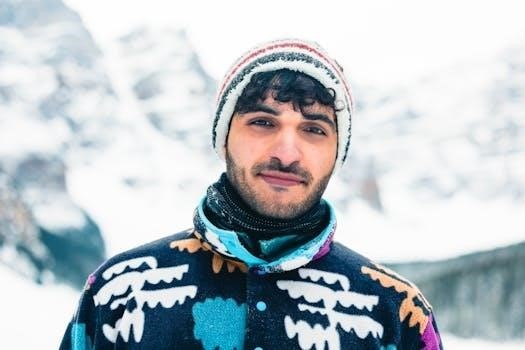La Bailarina de Auschwitz⁚ An Overview
Edith Eger’s harrowing experience in Auschwitz is chronicled. She was sixteen when Nazis invaded her Hungarian town, deporting her family. Upon arrival, she faced immediate separation from her parents.
Edith Eger’s Early Life and Deportation
Born in Hungary, Edith Eger was a teenager when the Nazis invaded in 1944, marking a brutal turning point in her life. She was only sixteen years old when her family was forcibly removed from their home, a scene filled with confusion and fear, as they were taken to Auschwitz. The night raid and the subsequent journey to the camp were traumatic, setting the stage for unimaginable hardship. This displacement tore her away from her familiar life, thrusting her into the horrors of the Holocaust. Her early life, rooted in a close-knit family within a small Hungarian town, was shattered by the Nazi invasion. The family, consisting of her father, a tailor; her mother, a homemaker; and her sister Magda, faced the full force of Nazi persecution. The initial experience involved being uprooted from their home and transported to a brick factory internment camp, where they had to survive with minimal resources under precarious conditions. This sudden and violent disruption of her adolescence foreshadowed the immense challenges and resilience that would define her survival story. The once vibrant and hopeful young girl was now confronted with the grim reality of Nazi oppression, forever altering the course of her life and setting her on a path of unimaginable suffering and eventual triumph over adversity. The loss of her innocence and the separation from her family marked the beginning of a long and arduous journey through the depths of human cruelty.

Auschwitz Experience
Upon arrival at Auschwitz, Edith faced the immediate horror of family separation. Her parents were sent to the gas chamber, while she and her sister Magda remained together, facing imminent death in the brutal camp conditions.
Arrival and Separation from Family
Edith Eger’s arrival at Auschwitz marked the beginning of an unimaginable nightmare. Torn from her home in Hungary during the Nazi invasion, she, along with her family, were forcibly transported to the infamous concentration camp. The journey itself was fraught with fear and uncertainty, packed into overcrowded cattle cars with little food or water, and the constant dread of the unknown that awaited them. Upon arrival, the stark reality of Auschwitz became immediately apparent – a place of systematic dehumanization and death.
The selection process was brutal and swift. As the train doors opened, families were ripped apart, with men, women, and children herded in different directions. In a moment that would forever haunt her, Edith was separated from her parents. They were immediately deemed unfit for work and sent directly to the gas chambers, their fate sealed without a second glance. Edith and her sister, Magda, clung to each other, their fear compounded by the realization that their parents were gone, and their own survival was far from certain.
The chaos and confusion were overwhelming, the air thick with the stench of burning flesh and the cries of despair. Stripped of their belongings and identities, they were reduced to mere numbers, branded on their arms as a mark of their enslavement. The initial shock of arrival quickly gave way to the harsh realities of camp life – the constant hunger, the backbreaking labor, the ever-present threat of violence, and the knowledge that death was a constant companion. Despite the unimaginable horrors surrounding them, Edith and Magda found strength in their bond, clinging to the hope that they could somehow survive this living hell and find their way back to freedom. The memory of their parents, and the promise to honor their lives, became the driving force that kept them going, even in the darkest of moments. The separation was not only physical but also a deep emotional wound that would take years to heal, shaping Edith’s understanding of trauma and her lifelong dedication to helping others overcome their own suffering.
Survival in the Camp
In the brutal environment of Auschwitz, survival was a daily struggle, a relentless test of physical and mental endurance. Edith Eger, along with her sister Magda, faced unimaginable horrors, yet they found ways to persevere amidst the dehumanization and despair. One of the key factors in their survival was their unwavering bond. They supported each other, sharing meager rations, offering comfort during moments of despair, and reminding each other of their shared humanity. This sisterly connection provided a crucial lifeline in a world designed to strip away all sense of identity and hope.
Edith’s background as a dancer also played an unexpected role in her survival. One evening, she was forced to dance for the amusement of the Nazi officers. This act, though humiliating and degrading, ultimately saved her life, providing her with extra food and a temporary reprieve from the grueling labor. It was a stark reminder of the arbitrary nature of survival in the camp, where a moment of entertainment could mean the difference between life and death.
Beyond physical survival, Edith fought to maintain her mental and emotional well-being. She clung to memories of her life before the war, recalling moments of joy, love, and connection. She used her imagination to escape the horrors around her, mentally rehearsing dance routines and envisioning a future where she would be free. This mental resilience, the ability to find moments of peace and hope even in the darkest of circumstances, was essential to her survival.
The will to live was fueled by the hope of reunion with loved ones and the determination to tell their story. Edith witnessed countless acts of cruelty and suffering, but she also saw moments of kindness and compassion. These small acts of humanity, shared between prisoners, served as a reminder that even in the depths of hell, the human spirit could endure. The daily struggle for survival involved navigating the complex social dynamics of the camp, avoiding the attention of the guards, and finding ways to supplement their meager rations. It was a constant game of strategy and risk, where one wrong move could have fatal consequences. Yet, through it all, Edith and Magda held onto their hope, their determination, and their unwavering love for each other, which ultimately allowed them to emerge from the ashes of Auschwitz with their spirits unbroken.

Post-War Life and Healing
After surviving Auschwitz, Edith Eger moved to Czechoslovakia before ultimately finding refuge in the United States. This transition marked the beginning of a long journey toward healing from the trauma she endured during the Holocaust.
Move to Czechoslovakia and the United States
Edith Eger’s journey to recovery began with a move to Czechoslovakia following her liberation from Auschwitz. This relocation represented a crucial step away from the immediate horrors of the concentration camp and towards rebuilding her life. However, the scars of the Holocaust ran deep, and the challenges of adjusting to a post-war world were significant. The trauma she experienced continued to affect her, making it difficult to find stability and peace. Seeking a fresh start and a chance for a better future, Eger eventually immigrated to the United States. This move across the Atlantic was more than just a change of scenery; it was an attempt to escape the shadows of her past and create a new identity for herself. In America, she hoped to find opportunities for education, personal growth, and ultimately, healing. The United States offered her a sense of anonymity and the freedom to pursue her dreams without being constantly defined by her experiences in Auschwitz. This new chapter in her life was filled with both hope and uncertainty as she navigated a new culture, language, and society. Despite the challenges, Eger was determined to build a life filled with purpose and meaning, driven by a desire to not let the horrors she had witnessed define her existence. The move to the United States proved to be a pivotal moment in her journey, setting the stage for her transformation into a renowned psychologist and author.
Becoming a Psychologist
In the United States, Edith Eger embarked on an academic path that would ultimately lead her to becoming a respected psychologist. Driven by her own experiences with trauma and survival, she felt a strong calling to help others heal from their emotional wounds. This personal connection to suffering fueled her determination to pursue a career in psychology, believing she could make a difference in the lives of those struggling with mental health challenges. Eger dedicated herself to her studies, earning a degree in psychology and eventually a doctorate. Her academic journey was not without its hurdles, as she grappled with the memories of Auschwitz and the emotional toll of revisiting her past. However, she persevered, using her experiences as a source of strength and empathy. As she delved deeper into the field of psychology, Eger was particularly drawn to the study of trauma and resilience. She sought to understand the psychological mechanisms that allowed individuals to cope with adversity and find meaning in their suffering. Her own life story became a powerful testament to the human capacity for survival and healing, and she incorporated her personal insights into her clinical practice. Mentorship played a crucial role in Eger’s development as a psychologist. She had the opportunity to work with and learn from influential figures in the field, including Viktor Frankl, whose teachings on finding meaning in suffering deeply resonated with her. Frankl’s influence helped shape her therapeutic approach, emphasizing the importance of individual choice and the search for purpose in life. Through her work as a psychologist, Eger has helped countless individuals overcome trauma, anxiety, and depression. Her unique perspective, combined with her clinical expertise, has made her a sought-after therapist and speaker. She has become an advocate for mental health awareness and a source of inspiration for those seeking to heal from their own emotional wounds.

“The Choice”⁚ Eger’s Book
“The Choice,” written when Eger was 87, is a powerful narrative of resilience. It explores her Auschwitz experience, post-war life, and psychological insights. The book emphasizes overcoming trauma and finding freedom.
Themes of Resilience and Forgiveness
Eger’s “The Choice” profoundly explores themes of resilience and forgiveness, showcasing humanity’s capacity to heal from unimaginable trauma. Her experiences within Auschwitz, marked by the loss of her parents and the constant threat of death, serve as a stark backdrop against which her remarkable resilience shines. The book details the brutal realities of survival in the camp, highlighting moments where Eger’s mental strength and courage were tested to their limits. Despite the horrific conditions, she found ways to maintain hope and inner freedom, illustrating a powerful ability to adapt and endure even in the face of extreme adversity. This resilience is not merely about survival; it is about actively choosing to live and find meaning despite the trauma. Forgiveness, another central theme, is presented not as an act of condoning the atrocities committed against her but as a means of liberating herself from the chains of hatred and bitterness. Eger’s journey towards forgiveness is complex and deeply personal, involving a gradual process of understanding and acceptance. She emphasizes that holding onto anger and resentment only perpetuates suffering, while choosing forgiveness allows for healing and the possibility of a brighter future. Through her own story and the stories of those she has helped as a psychologist, Eger demonstrates that forgiveness is a pathway to reclaiming one’s life and finding peace after trauma. The book also touches on the importance of mental resistance and moral courage, highlighting the strength of the human spirit when faced with dehumanization and oppression. Eger’s life and work inspire readers to confront their own challenges with resilience and to seek freedom from the emotional burdens of the past through the transformative power of forgiveness. Ultimately, “The Choice” is a testament to the enduring strength of the human spirit and the capacity to find hope and healing even in the darkest of times.
Impact and Reception of the Book
“The Choice,” Edith Eger’s memoir, has garnered significant acclaim for its powerful message of resilience, forgiveness, and the human capacity to heal from trauma. The book has resonated deeply with readers worldwide, becoming a bestseller and receiving widespread positive reviews. Critics and readers alike have praised Eger’s honest and compelling narrative style, which vividly portrays her experiences in Auschwitz and her subsequent journey toward healing and self-discovery. The book’s impact is evident in its ability to inspire and empower individuals facing their own challenges. Many readers have shared how Eger’s story has given them the courage to confront their past traumas, find meaning in their suffering, and choose a path of forgiveness and growth. “The Choice” has also been recognized for its contribution to the fields of psychology and trauma recovery. Eger’s insights, drawn from her personal experiences and her work as a psychologist, offer valuable perspectives on how to overcome adversity and cultivate mental resilience. The book’s themes of resilience and forgiveness have resonated with readers from diverse backgrounds, making it a source of inspiration for those seeking to heal from trauma. Its message of hope and empowerment has been particularly impactful in a world grappling with various forms of suffering and injustice. The positive reception of “The Choice” is also reflected in its presence on bestseller lists and its widespread availability in bookstores and libraries. The book’s success has helped to raise awareness about the importance of trauma recovery and the potential for healing and growth even in the face of unimaginable circumstances. Overall, “The Choice” has had a profound and lasting impact on readers, inspiring them to embrace resilience, practice forgiveness, and choose a life of meaning and purpose. Its message of hope and healing continues to resonate with audiences worldwide, solidifying its place as a powerful and transformative work.

Viktor Frankl’s Influence
Viktor Frankl, a renowned psychiatrist and Holocaust survivor, profoundly influenced Edith Eger’s life and work, particularly her approach to trauma recovery and her understanding of the human capacity for finding meaning in suffering. Frankl’s experiences in Auschwitz, where he developed his theory of logotherapy, served as a powerful example for Eger. Logotherapy emphasizes the importance of finding meaning and purpose in life, even in the face of extreme adversity. Frankl’s teachings resonated deeply with Eger, who had also endured the horrors of Auschwitz. She found solace and inspiration in his belief that individuals have the power to choose their attitude and find meaning in their suffering, even when faced with circumstances beyond their control. Eger’s encounter with Frankl proved transformative, shaping her path toward becoming a psychologist and dedicating her life to helping others heal from trauma. Frankl’s emphasis on finding meaning and purpose in life became a central tenet of Eger’s therapeutic approach. She integrated logotherapy principles into her work with patients, helping them to identify their values, discover their purpose, and find meaning in their experiences, even the most painful ones. Frankl’s influence is evident in Eger’s book, “The Choice,” which explores the themes of resilience, forgiveness, and the importance of finding meaning in suffering. Eger’s story exemplifies Frankl’s belief that individuals can find strength and hope even in the darkest of times. Her ability to overcome her trauma and dedicate her life to helping others is a testament to the power of logotherapy and the human spirit. Frankl’s teachings have had a lasting impact on Eger’s life and work. She credits him with helping her to understand the importance of finding meaning in suffering and for inspiring her to use her experiences to help others heal from trauma. His influence continues to inspire her work as a psychologist and her message of hope and resilience to audiences worldwide. Eger’s life stands as a powerful example of Frankl’s teachings, demonstrating the transformative potential of logotherapy and the human capacity for finding meaning in the face of unimaginable suffering. The impact of Frankl’s work is undeniable in Eger’s dedication to helping others find their own path to healing and self-discovery.
